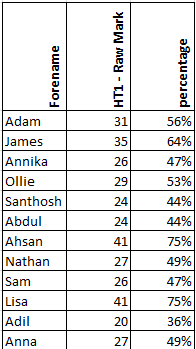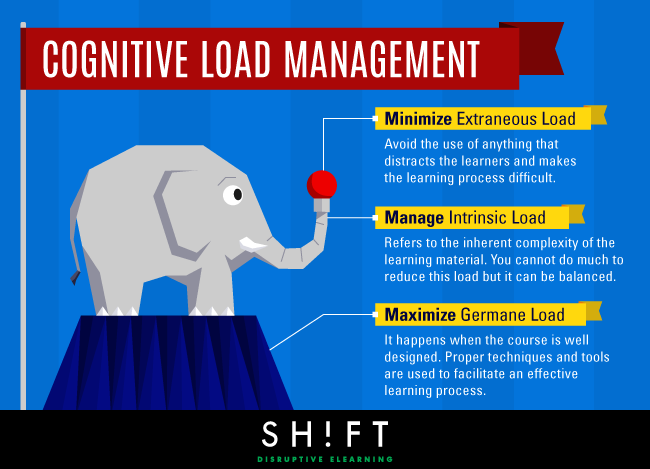
So, you’re convinced of the worked example effect, and you use it in lessons with great regularity and regular success. Yet have you ever worked through an example only for your students to be completely flabbergasted?
This happened to me the first time I taught quadratic simultaneous equations to my year 11s (set 2/4). They were pretty solid in solving quadratics and at simultaneous equations by elimination – we’d just spent half the lesson revising them. I put this example up on the screen:

and I duly worked through it, rearranging 2, substituting into 1, reminding them of how to expand a binomial squared, expanding and simplifying and solving and then finally substituting again. In fairness I should have stopped much earlier, from the puzzled sounds that were emanating from the class. But it soon became clear from questioning that students had absolutely no idea what had just happened. The problem: total cognitive overload. Whoops! I tried to start again, emphasising each step, but I had lost most of the class’s motivation, and we duly went back to revising quadratics and simultaneous equations.
Fast forward a term (I hoped that was enough time for them to recover from my first attempt). Same class, same topic – yet very different approach. I didn’t start with the problem, or work through an example. Instead, I tackled through the problem in reverse. Again, the starter was a mix of quadratic equations of varying complexity. But after we’d revised that, this was my sequence of examples, in this order:

Slide 1
This was the first slide – and it was very easy compared to lots of the questions in our starter. I picked a student to solve it for the class, and she quickly did.

Slide 2
This was slightly more complicated, but again within the reach of the class. I again picked a student, asking what was different, and then asking them to solve it. However, upon rearranging, many students immediately recognised that it led to the same problem as before, and so we already knew the solutions.

Slide 3
Slide 3 – a great way to highlight some misconceptions – I picked a mid-attaining student from the class who correctly identified the first step as expand the brackets, but incorrectly stated it as the classic ‘x squared plus 4’. Students discussed this briefly (whilst I went mock-apoplectic at him), and thankfully other students quickly corrected him. After that pause, we simplified and saw – it was exactly the same as the problems in the previous slides, and again we knew the answers. And then finally:

Slide 4
Quadratic simultaneous equations – finally, our new bit of learning. I introduced the concept of expression substitution to them, and showed how it worked, and the resulting equation that formed. And once again, to no-one’s surprise by this stage, we were led to exactly the same equation that we had had in the previous slide. As a result, the rest of the process was trivial – I simply told them to ‘solve the remaining equation as we just did’, flicked back each slide (where we’d solved each problem on the board), and students knew exactly what I meant. I then immediately went back to the first slide, and the solution we’d arrived at there, and asked if that was the final answer. Impressively, a large number of students were able to immediately identify that we had to solve for y as well. It was clear that this method of explaining in reverse had avoided the catastrophic working memory overload of my first attempt. And, when it came to trying problems, the entire class (ranging from predicted grades of Cs to A*s) were able to solve at least several problems successfully.
These two experiences couldn’t have been more different. The only difference was the un-intuitive – but highly successful – reverse ordering of my explanation. Like many good ideas, I originally encountered this from Kris Boulton, who used it in the context of linear simultaneous equations; I’m blogging about it just because I haven’t seen it mentioned anywhere else, but it’s been massively helpful to me in this instance and several others, and I’ve wished I’d used it more in other topics.
I think the key pedagogical insights of this method is as follows:
- In worked examples, focus attention and cognitive load, as far as possible, on the new concepts/processes/facts that you want pupils to learn.
- Recognise that if a worked example contains parts that pupils are already familiar with, it nonetheless contributes to cognitive load, and thus may hinder their ability to grasp what’s new.
- Therefore, if a worked example involves steps that utilise lots of other previously-learnt things, work through the problem in reverse, establishing the most basic steps before you move onto what’s new.
In the example above, the new concept was of substituting between equations, and the rest of the example reduced to things that pupils already knew how to do. Yet as my first experience showed, those parts of the example involving rearrangement/simplifying/solving quadratics overloaded my pupils, who were undoubtedly still trying to get to grips with the idea of equation substitution. As my second experience showed, far better to start with what they felt comfortable with, establish it (and in the case of (x+2)^2, get the peripheal & familiar misconceptions out of the way there), and work backwards until we reached what was new.
This method can be used in pretty much any topic which involves multiple steps. It can work in KS3 – for example, when teaching ordering fractions, decimals and percentages:
First example/problem: Convert 1/2, 1/4, 3/10 into decimals
Second problem: ‘Order 0.6, 0.2, 0.5, 0.25, 0.62 in ascending order.’
Worked example: ‘Order 3/10, 0.2, 1/2, 1/4, 0.62 in ascending order.’
A similar principle also works in KS5 teaching too, especially well, as most questions are rather long. Since questions here have numerous parts and it’s a bit harder to separate them out, I often apply a slightly different but related approach: pre-provide everything that the students already know how to do in the example, so that they can focus on the new content.
For example, the Edexcel C2 textbook offers something like this example for binomial expansion approximations: ‘Find the first four terms of (1+8x)^6, and by using a suitable substitution, use your result to find an approximate value to (1.016)^6.’ Yet the only thing that’s new is the last bit – approximations using substitutions. So, when I explained this new process, I simplified the example by providing the familiar part of it for them: ‘The first four terms of (1+8x)^6 are 1 + 48x + 960 x^2 + 10240 x^3. By using these and a suitable substitution, use your result to find an approximate value to (1.016)^6′.
By pre-providing the first part of the answer within the example, we instantly honed in on the new content, directed all our attention to that, had lots of time to ask questions about it, and weren’t held up by having to perform the expansion. Interestingly, when students eventually did see an exam-style question, they twigged by themselves the need to expand it first, and happily did so. Similarly, with my year 11s and the simultaneous quadratics, most of the class worked out for later questions (with a bit of discussion with their partner) that they had to rearrange some equations before substituting them. I think this happened because, having been able to focus entirely on the new process during the reverse explanation, the students had already grown quite comfortable with it, and were thus able to apply other parts of their prior knowledge to new and harder questions without much further instruction from me.
We naturally want to introduce what’s new first. Yet if this is then followed by lots of other familiar content in order to get to the final answer, we run the risk of cognitive overload in our pupils. As teachers who have mastered the curriculum, this often doesn’t occur to us, so I’m thankful for that original lesson with my year 11s for bringing this strategy back to mind. Either reverse your explanations so more familiar final steps are addressed first, or just pre-provide the familiar steps of an example, so that you can focus pupils’ attention and working memory on what’s new.














